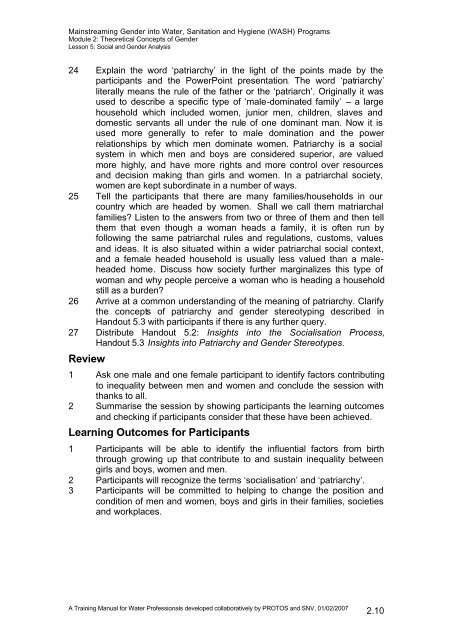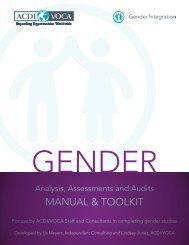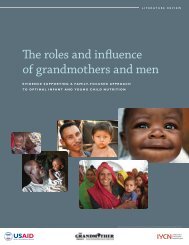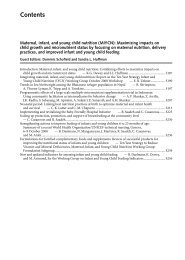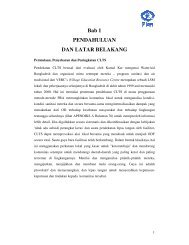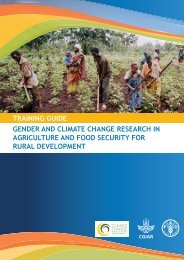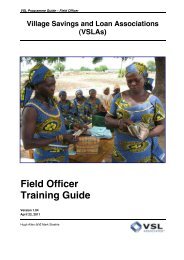Module 2. Theorethical Concepts of Gender - FSN Network Portal
Module 2. Theorethical Concepts of Gender - FSN Network Portal
Module 2. Theorethical Concepts of Gender - FSN Network Portal
You also want an ePaper? Increase the reach of your titles
YUMPU automatically turns print PDFs into web optimized ePapers that Google loves.
Mainstreaming <strong>Gender</strong> into Water, Sanitation and Hygiene (WASH) Programs<br />
<strong>Module</strong> 2: Theoretical <strong>Concepts</strong> <strong>of</strong> <strong>Gender</strong><br />
Lesson 5: Social and <strong>Gender</strong> Analysis<br />
24 Explain the word ‘patriarchy’ in the light <strong>of</strong> the points made by the<br />
participants and the PowerPoint presentation. The word ‘patriarchy’<br />
literally means the rule <strong>of</strong> the father or the ‘patriarch’. Originally it was<br />
used to describe a specific type <strong>of</strong> ‘male-dominated family’ – a large<br />
household which included women, junior men, children, slaves and<br />
domestic servants all under the rule <strong>of</strong> one dominant man. Now it is<br />
used more generally to refer to male domination and the power<br />
relationships by which men dominate women. Patriarchy is a social<br />
system in which men and boys are considered superior, are valued<br />
more highly, and have more rights and more control over resources<br />
and decision making than girls and women. In a patriarchal society,<br />
women are kept subordinate in a number <strong>of</strong> ways.<br />
25 Tell the participants that there are many families/households in our<br />
country which are headed by women. Shall we call them matriarchal<br />
families? Listen to the answers from two or three <strong>of</strong> them and then tell<br />
them that even though a woman heads a family, it is <strong>of</strong>ten run by<br />
following the same patriarchal rules and regulations, customs, values<br />
and ideas. It is also situated within a wider patriarchal social context,<br />
and a female headed household is usually less valued than a maleheaded<br />
home. Discuss how society further marginalizes this type <strong>of</strong><br />
woman and why people perceive a woman who is heading a household<br />
still as a burden?<br />
26 Arrive at a common understanding <strong>of</strong> the meaning <strong>of</strong> patriarchy. Clarify<br />
the concepts <strong>of</strong> patriarchy and gender stereotyping described in<br />
Handout 5.3 with participants if there is any further query.<br />
27 Distribute Handout 5.2: Insights into the Socialisation Process,<br />
Handout 5.3 Insights into Patriarchy and <strong>Gender</strong> Stereotypes.<br />
Review<br />
1 Ask one male and one female participant to identify factors contributing<br />
to inequality between men and women and conclude the session with<br />
thanks to all.<br />
2 Summarise the session by showing participants the learning outcomes<br />
and checking if participants consider that these have been achieved.<br />
Learning Outcomes for Participants<br />
1 Participants will be able to identify the influential factors from birth<br />
through growing up that contribute to and sustain inequality between<br />
girls and boys, women and men.<br />
2 Participants will recognize the terms ‘socialisation’ and ‘patriarchy’.<br />
3 Participants will be committed to helping to change the position and<br />
condition <strong>of</strong> men and women, boys and girls in their families, societies<br />
and workplaces.<br />
A Training Manual for Water Pr<strong>of</strong>essionals developed collaboratively by PROTOS and SNV, 01/02/2007<br />
<strong>2.</strong>10


